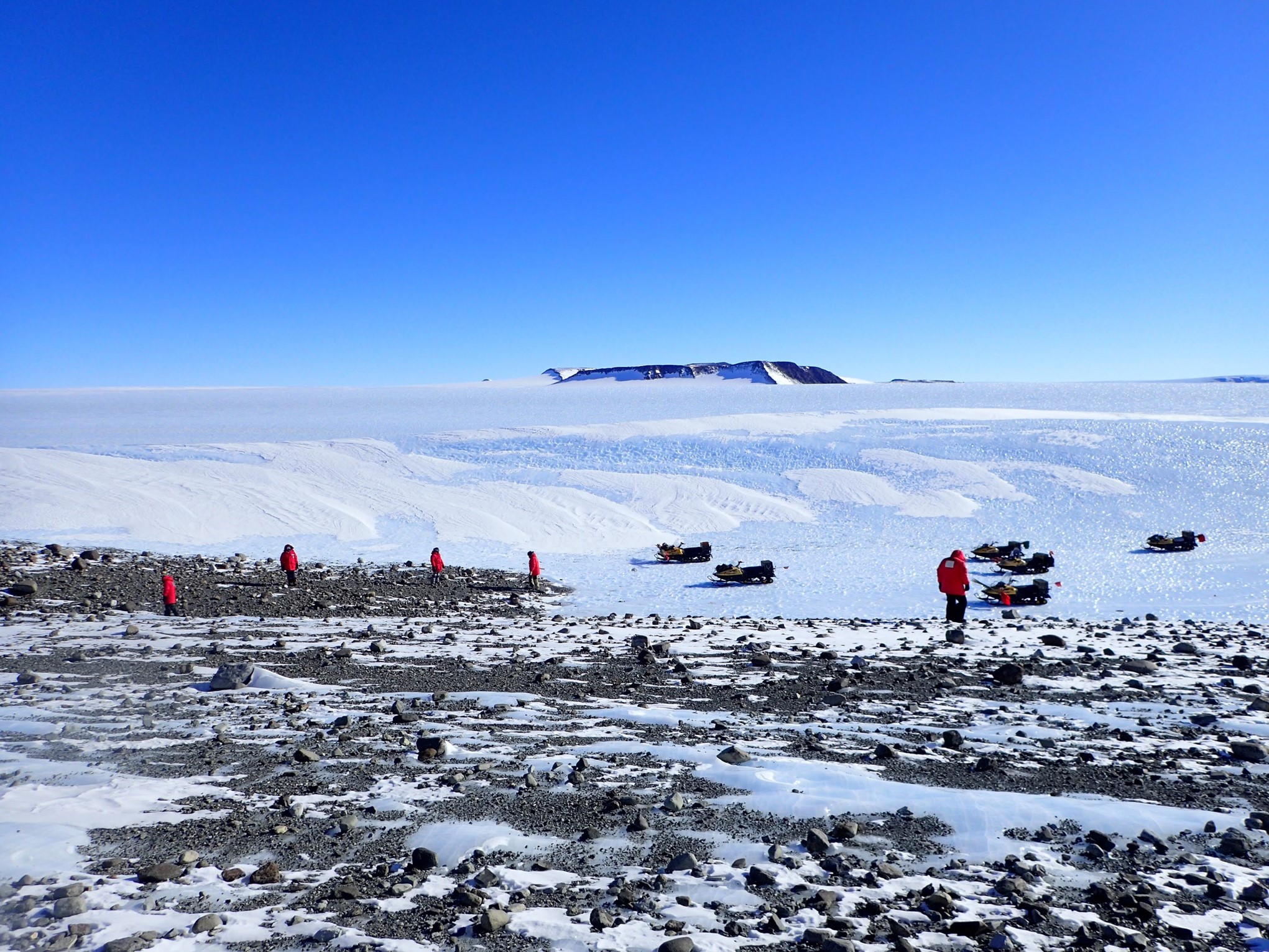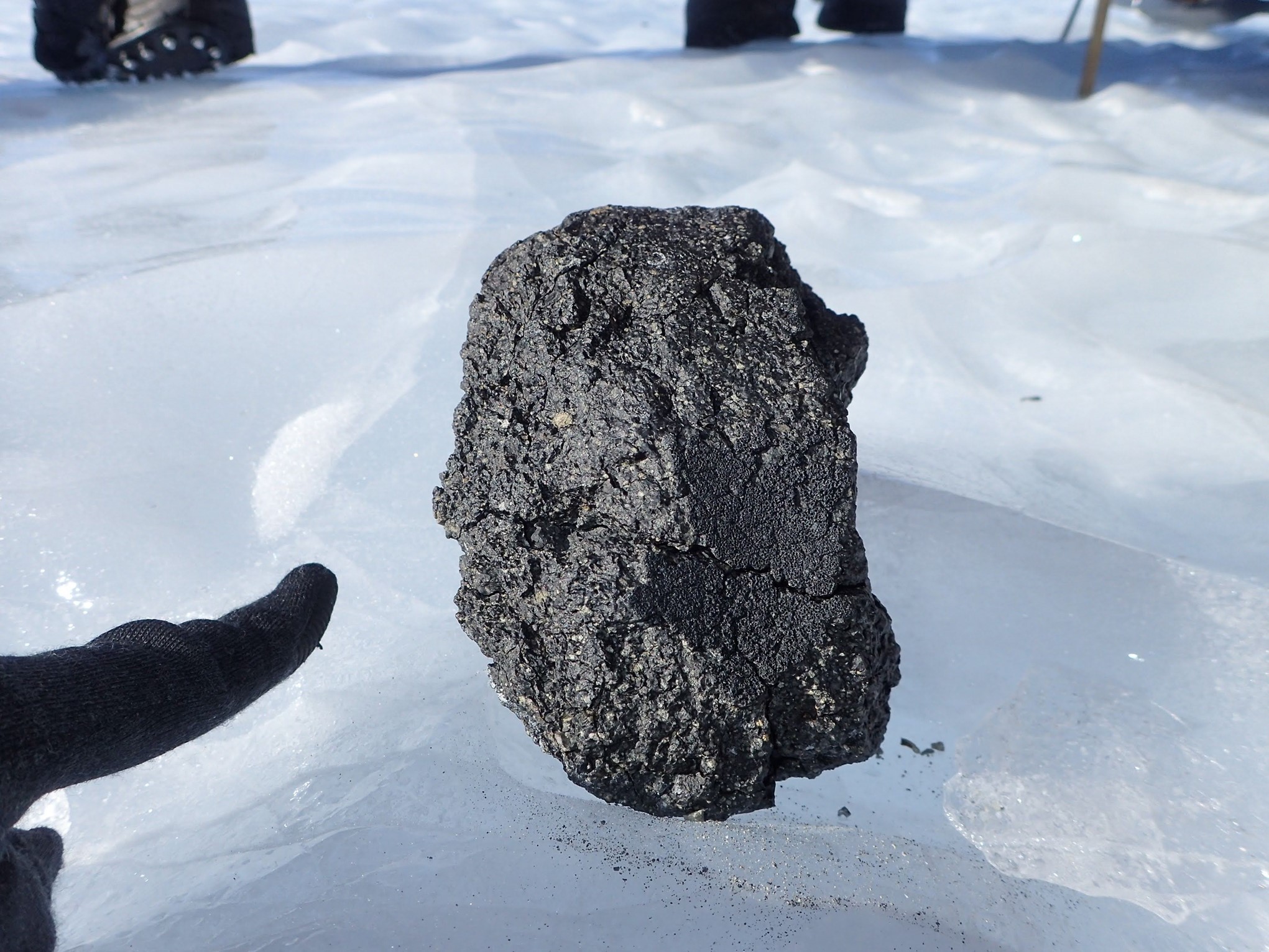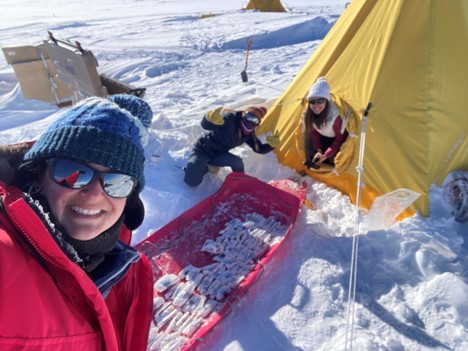Program News
Curator Comments
Kevin Righter, NASA-JSC
This newsletter announces the availability of 125 new meteorites collected from the 2018-19 ANSMET season in the Dominion Range (DOM), as well as one new chondrite from the Allan Hills (ALH). The latter was recovered in 2022-23 season by the COLDEX group operating in the Allan Hills region. We extend our thanks to Jacob Morgan of Scripps Institution of Oceanography for providing detailed information on this find and ensuring its safe transport to McMurdo and on to JSC. New samples in the newsletter include a CR2 chondrite, several low-grade ordinary chondrites (L3.5 and L3.6), and a brecciated eucrite. In addition to these new samples, we announce the reclassification or pairing updates for many samples in our collection, including many HEDs from the Miller Range.
Reclassification and pairing updates
Based on newly available data, or data acquired since initial classification, we re-classify the following samples. More detailed information, references upon which the change is based, are in notes following this table in the order of appearance of samples in the table.
Table 1: Reclassification information for some achondrites and chondrites
| Sample | Original classification | AMN | New classification | references |
|
|
|
|
|
Achondrites |
|
|
|
|
MIL 07665 |
Howardite |
32,1 |
Diogenite |
[1] |
MIL 090153 |
Howardite |
34,2 |
Eucrite (Brecciated) |
[1] |
MIL 07009 |
Howardite |
31,2 |
Eucrite (Brecciated) |
[1] |
MIL 11294 |
Howardite |
36,1 |
Eucrite (Brecciated) |
[1] |
MIL 07664 |
Howardite |
32,1 |
Eucrite (Brecciated) |
[1] |
MIL 05062 |
Howardite |
30,1 |
Eucrite (Brecciated) |
[1] |
MIL 05085 |
Howardite |
29,2 |
Eucrite (Brecciated) |
[1] |
MIL 05165 |
Howardite |
30,1 |
Eucrite (Brecciated) |
[1] and petrogr. |
MIL 090640 |
Howardite |
35,2 |
Eucrite (Brecciated) |
[1] and petrogr. |
|
|
|
|
|
MIL 07006 |
Lunar Anorth. Breccia |
31,2; 33,1 |
Lunar Polymict Anorthositic Regolith Breccia |
Added polymict to reflect the presence of minor basaltic and major anorthositic clasts as well as glassy spherules in the matrix [7]. |
MIL 13317 |
Lunar Anorth. Breccia |
38,2 |
Lunar Polymict Regolith Breccia |
Dropped the anorthositic intensifier and added polymict to reflect the presence of subequal basaltic and anorthositic clasts. Added regolith to name consistent with glassy matrix [8]. |
MIL 090036 |
Lunar Anorth. Breccia |
33,2 |
Lunar Anorthositic Regolith Breccia |
Revised the name based on glassy spherules reported in matrix (i.e., regolithic) [9]. Unpaired due to composition and CRE ages [10,11]. |
MIL 090034, MIL 090070, MIL 090075 |
Lunar Anorth. Breccia |
33,2 |
Lunar Anorthositic Regolith Breccia |
Paired these three based on CRE ages and composition, and revised the name based on glassy spherules reported in matrix (i.e., regolithic) [9,10,11] |
|
|
|
|
|
Chondrites |
|
|
|
|
LAR 12156 |
EH3 |
40,1 |
EL3 |
[2] and new analyses. |
DOM 18071 |
CM2 |
42,2 |
CO3.05 |
New oxygen and EMPA analyses (see notes below) |
SZA 12431 |
CO3 |
36,2 |
CM2 |
New oxygen and petrographic analyses (see notes below) |
MIL 090001 |
CR2 |
33,2; 35,1 |
C2 ungrouped |
Combination of geochemical and petrographic information ([3]-[6] and see notes below) |
DOM 10900 |
CO3 |
|
CO3.05 |
Based on [12]; Type II olivine Cr contents, CRE ages, and H, C, N bulk and isotopic compositions. |
DOM 14359 |
CO3 |
|
CO3.05 |
“ |
DOM 18070 |
CO3 |
|
CO3.05 |
“ |
DOM 08004 and pairs |
CO3 |
|
CO3.05 |
“ |
DOM 18286 |
CO3 |
|
CO3.2 |
“ |
DOM 19034 |
CO3 |
|
CO3.2 |
“ |
MIL 07099 and pairs |
CO3 |
|
CO3.05 |
“ |
MIL 11069 and pairs |
CO3 |
|
CO3.15 |
“ |
[1] Welten, K. et al. (2024) Terrestrial Ages and Pairing of HEDs from the Miller Range Icefields, Antarctica. LPSC abstract. 55th Lunar and Planetary Science Conference, #1295.
[2] Anzures, B. (2021) Volatiles and Redox in Mercury and Chondritic Parent Bodies: Insights from Experiments and Laboratory Analyses of Meteorites, Ph.D. Thesis. Brown University.
[3] Abreu, N. M. (2016) Why is it so difficult to classify Renazzo-type (CR) carbonaceous chondrites? - Implications from TEM observations of matrices for the sequences of aqueous alteration. Geochimica et Cosmochimica Acta, 194, 91-122.
[4] Alexander, C. M., and Bowden, R. (2018) Lewis Cliff (LEW) 85332 and Miller Range (MIL) 090001, a New Grouplet that is Distinct from the CR Chondrites? Meteoritics & Planetary Science Supplement 81: 6063.
[5] Keller, L. P., McKeegan, K. D., and Shard, Z. D. (2012) The Oxygen Isotopic Composition of MIL 090001: A CR2 Chondrite with Abundant Refractory Inclusions. 43rd Lunar and Planetary Science Conference, abstract #2065.
[6] Prestgard, T., Beck, P., Bonal, L., Eschrig, J., Gattacceca, J., Sonzogni, C., & Krämer Ruggiu, L. (2023) The parent bodies of CR chondrites and their secondary history. Meteoritics & Planetary Science, 58(8), 1117-1148.
[7] Joy, K. H., Crawford, I. A., & Snape, J. F. (2010) Lunar Meteorite Miller Range 07006: Petrography and VLT Basalt Clast Inventory. In 41st Annual Lunar and Planetary Science Conference (No. 1533, p. 1793).
[8] Curran, N. M., Joy, K. H., Snape, J. F., Pernet-Fisher, J. F., Gilmour, J. D., Nemchin, A. A., ... & Burgess, R. (2019) The early geological history of the Moon inferred from ancient lunar meteorite Miller Range 13317. Meteoritics & Planetary Science, 54(7), 1401-1430.
[9] Calzada-Diaz, A., Joy, K. H., Crawford, I. A., & Strekopytov, S. (2017) The petrology, geochemistry, and age of lunar regolith breccias Miller Range 090036 and 090070: Insights into the crustal history of the Moon. Meteoritics & Planetary Science, 52(1), 3-23.
[10] Nishiizumi, K., & Caffee, M. W. (2013) Relationships among six lunar meteorites from Miller Range, Antarctica based on cosmogenic radionuclides. In 44th Annual Lunar and Planetary Science Conference (No. 1719, p. 2715).
[11] Zeigler, R. A., & Korotev, R. L. (2016) Petrography and Geochemistry of Lunar Meteorite Miller Range 13317. In 47th Annual Lunar and Planetary Science Conference (No. 1903, p. 2554).
[12] Righter, K. et al. (2024) Pairing relations within CO3 chondrites recovered at the Dominion Range and Miller Range, Transantarctic mountains: Constraints from chondrule olivines, noble gas, and H, C, N bulk and isotopic compositions. Meteoritics and Planetary Science 59; https://doi.org/10.1111/maps.14146.
Detailed notes for reclassification or pairing updates:
Miller Range HEDs [1]
Reclassifications:
Based on new data and observations from several Miller Range HEDs we are proposing re-classifications as follows:
MIL 07665 has a low POEM value (percentage of eucrite material) similar to other MIL diogenites ~ 12 [1].
MIL 090153 has a high POEM value > 88, within the range of eucrites.
MIL 07009 has a high POEM ~ 90, within the range of eucrites.
MIL 11294 is a breccia and has petrography dominated by eucrite clasts.
MIL 07664 is a breccia and has petrography dominated by eucrite clasts.
MIL 05062 and MIL 05085 have high POEM values, within the range of eucrites; MIL 05165, MIL 090640, and MIL 15428 have identical petrography to MIL 05062 and MIL 05085. Pairing: All five of these can be paired based on combination of terrestrial ages, find location, and petrographic textures.
Pairing updates:
MIL 11041, 11291, 13079, and 15080 all paired based on young ages for 11291 and 15080, as well as identical textures and mineralogy of MIL 11041 and MIL 13079 to these two.
MIL 07003, MIL 07613 (4 - 090105, 090106, 090107), MIL 090159 (3 - 090220, 090221), MIL 090112 (7 - 090291, 11099, 11201, 11202, 11204, 11205), MIL 11197, MIL 11198, and MIL 11199. Combination of these three diogenite pairing groups as well as four previously unpaired masses to form a new large 18 member pairing group of diogenites MIL 07003; based on terrestrial ages, compositions, find locations, and petrographic textures.
MIL 090995, MIL 03368, MIL 15309, and MIL 07001 all remain unpaired due to their distinct or unique characteristics.
Chondrites:
LAR 12156 [2]
LAR 12156 was classified in AMN 40, no. 1 as an EH3 chondrite. Analyses originally reported for the FeNi metal phases included 3 wt% Si. Brendan Anzures received a thin section of LAR 12156 and carried out a detailed study of the metal and sulfide phases and found that the metal contained < 1.4 wt% Si, and in the range of EL chondrites [2]. In addition, Anzures found alabandite to be present in the section which is also more consistent with classification as an EL chondrite (niningerite being more common in EH3) [2]. Smithsonian Antarctic meteorite curator Corrigan re-analyzed LAR 12156 metal grains for this newsletter and found the FeNi to contain 1.4 wt% Si (average of 10 analyses). Based on the observations of Anzures and the follow-up analyses of Corrigan, we now re-classify LAR 12156 as an EL3 chondrite.
MIL 090001
MIL 090001 was classified as a CV2, then reclassified as a CR2. It has some affinity to CR chondrites including bulk composition and oxygen isotopes but details of its petrography and geochemistry are inconsistent with CR. Thus, even since the new classification there are lingering doubts about this sample being a CR chondrite, including the degree of aqueous alteration, the presence of more CAIs than a typical CR, and the bulk and isotopic H, C, and N compositions. For this reason we will re-classify this sample as ungrouped C2.
DOM 18071
Oxygen isotopes (Table 2), Cr in Type II chondrule olivines, and hand specimen characteristics all suggest a possible pairing with DOM 10900 or DOM 18070, both of which are CO 3.05. DOM 18071 has Cr2O3 = 0.36 wt.% (σ = 0.07) for 43 analyses on olivines from Type II FeO-rich chondrules in section DOM 08071 ,5. A pairing between these several samples could be the focus of a future effort, but they are currently not paired to be conservative. DOM 18071 is re-classified here from CM to CO.
SZA 12431
Oxygen isotopes (Table 2) and overall petrography (high matrix, rare chondrules) both indicate re-classification from CO to CM chondrite is in order.
New oxygen data for some carbonaceous chondrites
A new analytical capability at ARES has allowed us to measure oxygen isotopic values in Antarctic meteorite samples as an aid in classification. Triple-oxygen-isotope compositions were measured using a laser fluorination system and Isotope Ratio Mass Spectrometer (MAT 253) located at JSC. The laser fluorination system was designed in-house and uses BrF5 as a reactant for quantitative conversion of silicates and oxides to oxygen gas (O2) and fluoride byproducts. The line contains an automated cryogenic and GC purification system for removing trace contaminated from the produced O2. Oxygen isotope results are reported on the VSMOW2-VSLAP scale. Inter-sample reproducibility (1σ) for isotopically homogenous standards is ±0.008‰ or better for δ'17O and ±0.1‰ or better for δ18O. The primary anchoring standard used is UWG-2 (Valley et al. 1995) run routinely with the accepted composition of δ18O = 5.750‰ and Δ'17O(0.5305) = -0.06‰ (Sharp and Wostbrock, 2021). Regular analysis of additional standards including purified Air-O2, NBS-28, UNM-SCO and various VSMOW2-VSLAP calibrated internal standards indicate a lack of significant scale distortion over a >30‰ range for the JSC IRMS setup.
As initial test analyses, we measured three CO chondrites whose classification is of highest confidence - DOM 08004, MIL 05013, and MIL 090010 (Table 2). For all three samples the new (duplicate) analyses are in excellent agreement with previous values published by [1]. In addition to these, we measured oxygen isotopes for eight additional samples for which classification seemed less confident based on fraction of matrix, chondrule abundance, or magnetic susceptibility values. For most samples the oxygen data supported the original classification and so no changes are necessary (Table 2). However, the following samples yielded values that suggest a need to re-classify: (a) DOM 18071 has lower δ17O and δ18O values than the field of CM chondrites, suggesting it should be a CO chondrite; (b) SZA 12431 has higher δ17O and δ18O values than the field of CO chondrites, suggesting it should instead be a CM chondrite. The other five samples remain classified as originally - MIL 090134, MIL 090233, and SZA 12432 are all CO chondrites, and MIL 13137 and MIL 13322 are both CM chondrites.
Valley, J.W., Kitchen, N., Kohn, M.J., Niendorf, C.R., & Spicuzza, M.J. (1995) UWG-2, a garnet standard for oxygen isotope ratios: strategies for high precision and accuracy with laser heating. Geochimica et Cosmochimica Acta 59, 5223-5231.
Sharp, Z.D., & Wostbrock, J.A. (2021) Standardization for the triple oxygen isotope system: Waters, silicates, carbonates, air, and sulfates. Reviews in Mineralogy and Geochemistry 86, 179-196.
Table 2: Oxygen isotope measurements on Antarctic meteorites
| Sample | δ17O | δ18O | Δ17O |
| DOM 08004, 20 | -7.001‰ | -3.879‰ | -4.984‰ |
| DOM 08004,20 | -6.865‰ | -3.735‰ | -4.923‰ |
| Literature [1] | -6.89 | -4.14 | -4.74 |
| MIL 05013, 37 | -8.524‰ | -5.673‰ | -5.574‰ |
| MIL 05013,37 | -6.918‰ | -4.299‰ | -4.682‰ |
| Literature [1] | -7.65 | -5.35 | -4.87 |
| MIL 090010, 48 | -7.490‰ | -4.943‰ | -4.919‰ |
| MIL 090010, 48 | -7.000‰ | -4.405‰ | -4.710‰ |
| Literature [1] | -7.26 | -4.73 | -4.8 |
| DOM 10900, 19 | -7.553‰ | -5.487‰ | -4.700‰ |
| DOM 10900,19 | -6.599‰ | -3.987‰ | -4.526‰ |
| DOM 10900 ,21 | -6.302‰ | -3.952‰ | -4.247‰ |
| DOM 18071, 11 | -5.955‰ | -3.173‰ | -4.305‰ |
| DOM 18071, 11 | -7.173‰ | -4.208‰ | -4.985‰ |
| MIL 090134, 6 | -7.406‰ | -5.663‰ | -4.461‰ |
| MIL 090134,6 | -9.385‰ | -7.700‰ | -5.381‰ |
| MIL 090233 ,6 | -6.468‰ | -4.426‰ | -4.167‰ |
| MIL 090233,6 | -7.193‰ | -4.977‰ | -4.605‰ |
| MIL 13137 ,4 | -2.458‰ | 0.610‰ | -2.775‰ |
| MIL 13137, 4 | -2.084‰ | 1.038‰ | -2.624‰ |
| MIL 13322, 4 | 3.558‰ | 9.608‰ | -1.438‰ |
| MIL 13322,4 | 3.553‰ | 9.577‰ | -1.427‰ |
| SZA 12431, 12 | -2.875‰ | 3.535‰ | -4.714‰ |
| SZA 12431,12 | -0.657‰ | 5.973‰ | -3.763‰ |
| SZA 12432, 7 | -4.829‰ | -0.661‰ | -4.485‰ |
| SZA 12432, 7 | -6.087‰ | -2.842‰ | -4.609‰ |
Values from literature from [A] are in this table for comparison purposes, but not plotted for clarity of presentation. Other values in plots are from references [B-D]. Δ17O = δ17O - 0.52 x δ18O.
[A] Alexander, C., Greenwood, R.C., Bowden, R., Gibson, J.M., Howard, K.T. and Franchi, I. A. (2018) A multi-technique search for the most primitive CO chondrites. Geochimica et Cosmochimica Acta 221, 406-420.
[B] Clayton, R.N. and Mayeda, T.K. (1999) Oxygen isotope studies of carbonaceous chondrites. Geochimica et Cosmochimica Acta 63, 2089-2104.
[C] Paris: Hewins, R.H., Bourot-Denise, M., Zanda, B., Leroux, H., Barrat, J.A., Humayun, M., Göpel, C., Greenwood, R.C., Franchi, I.A., Pont, S. and Lorand, J.P. (2014) The Paris meteorite, the least altered CM chondrite so far. Geochimica et Cosmochimica Acta 124, 190-222.
[D] Asukas: Kimura, M., Imae, N., Komatsu, M., Barrat, J.A., Greenwood, R.C., Yamaguchi, A., and Noguchi, T. (2020) The most primitive CM chondrites, Asuka 12085, 12169, and 12236, of subtypes 3.0-2.8: Their characteristic features and classification. Polar Science 26, 100565.
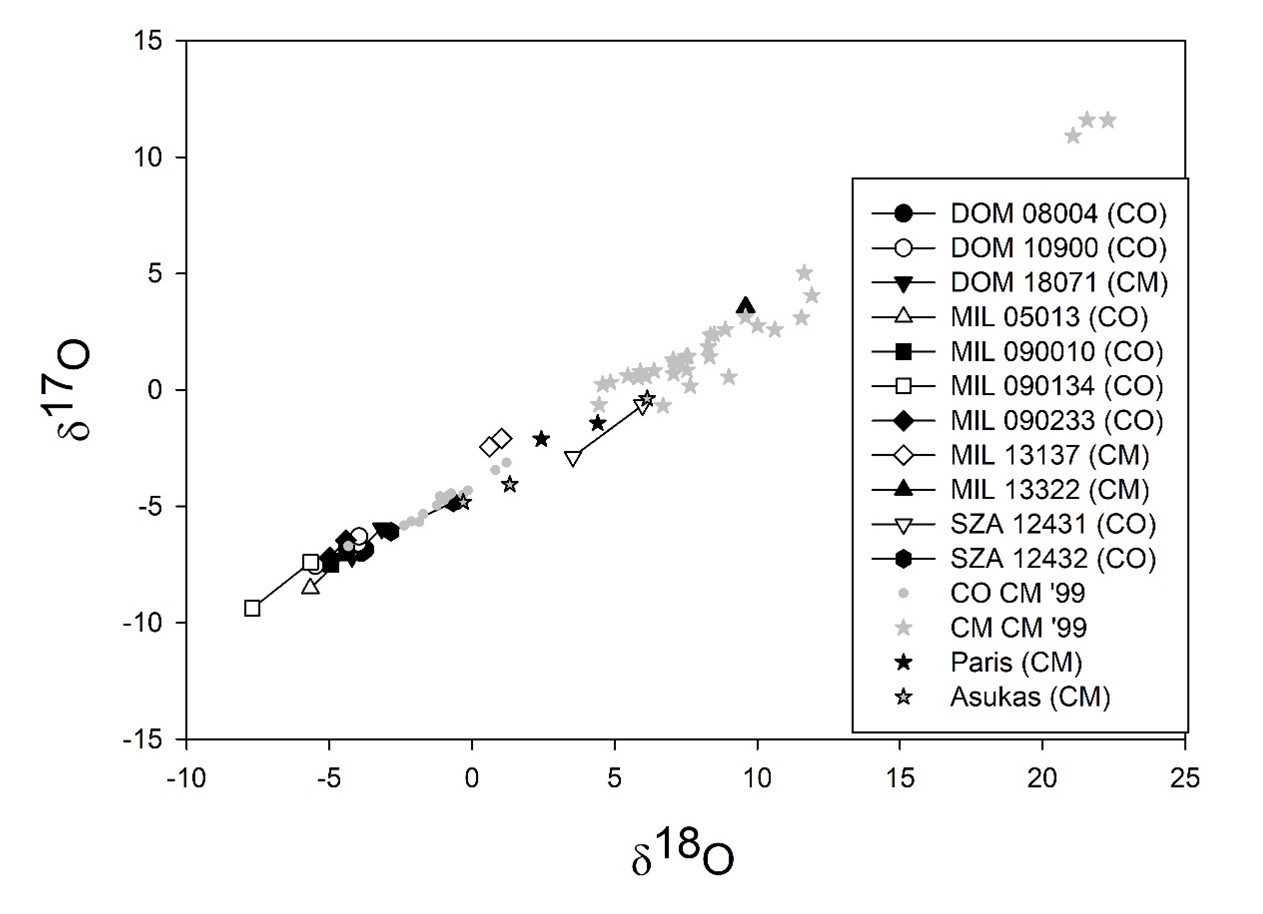
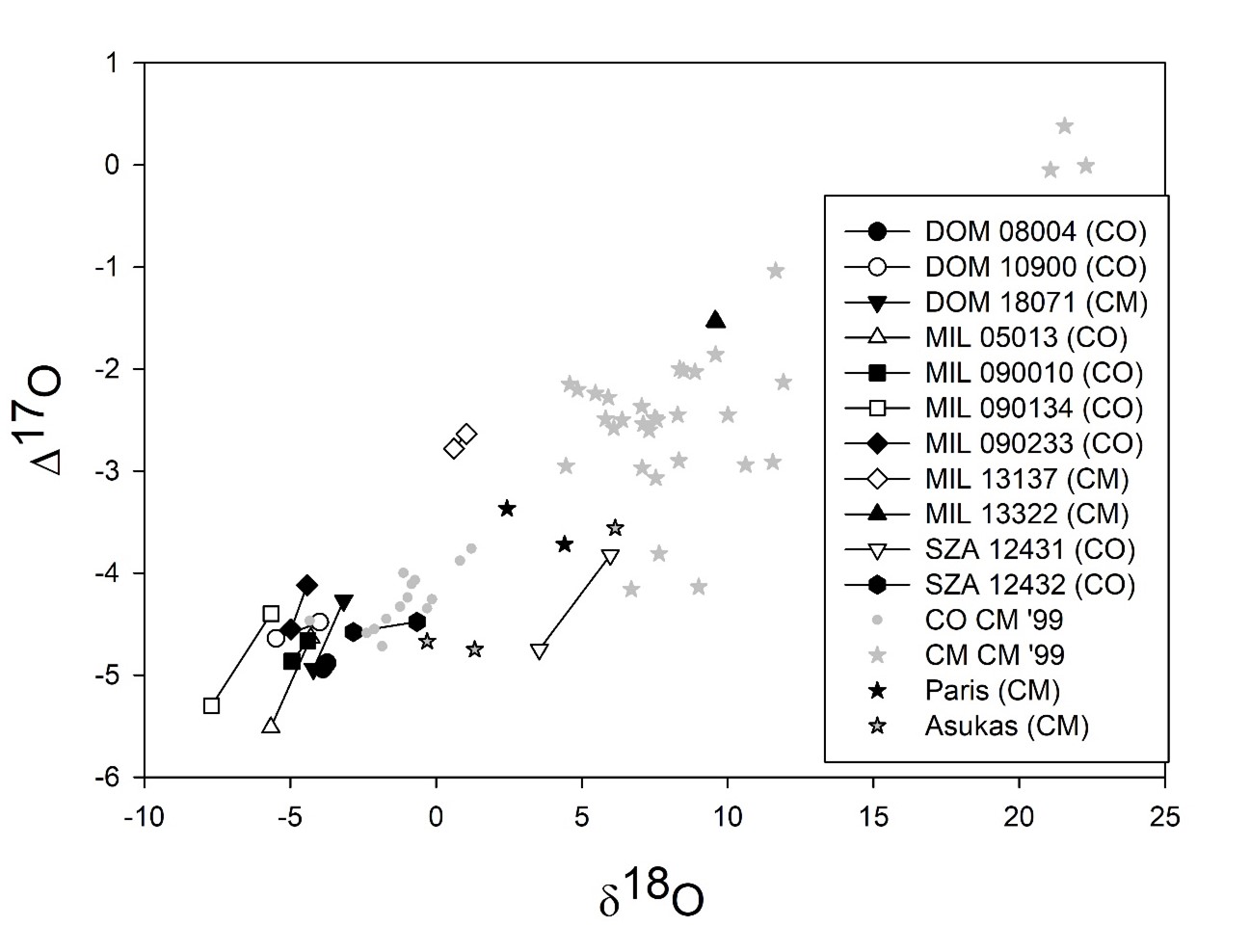
Report from the Smithsonian
Cari Corrigan, Research Geologist (Dept. of Mineral Sciences)
This newsletter announces the classification of 126 new meteorites (and two terrestrial rocks). The most exciting news in the Department of Mineral Sciences at the Smithsonian is that we have a new postdoctoral fellow, Dr. Amanda Ostwald (Ph.D. 2023, University of Nevada - Las Vegas), who has been helping with classifications for this newsletter. We are so happy to have Amanda (and her enthusiasm for breaking ordinary chondrites!) on board. In programmatic news, we have continued to digitize the rest of the data packs that accompany each and every Antarctic meteorite on its permanent transfer to the Smithsonian. All information about the meteorites, including every subsampling that it has experienced (how much mass, to whom it was delivered, etc.) is contained within these data packs. We thank the Smithsonian Institution Collections Care and Preservation Fund for awarding the funding to the Antarctic Meteorite Collection, and I personally thank (again!) Julie Hoskin and Kelsey Falquero for writing the proposals to obtain the funding and organizing this massive undertaking - which we can happily report, is now 80% complete!
ANSMET Report
Jim Karner
After three cancelled seasons, ANSMET finally got back into the field in 2023-24! The team was headed by Jim Karner and Brian Rougeux, joined by ANSMET vet Minako Righter, with first-timers Jon Friedrich, Lauren Edgar, Daniela Hernandez, Erin Gibbons, and Robert Citron. The team managed to finally (finally!) finish up search and recovery efforts at the Davis Nunataks and Mount Ward (DW).
Our thoughts before the start of the season were that we would be able to complete search and recovery efforts at DW in about 12-14 working days, and then we would move 25 km to the north to the Main Dominion Range icefields. The move was going to be an overland traverse by snowmobile with the assistance from the Twin Otter aircraft in carting over bulky and large cargo. But, alas, we ran out of time for the traverse. A bummer in a way for the field team members (a traverse sounds so exciting!) but that did not stop us from having a successful field season!
The season started by getting our mountaineer Brian Rougeux into the field (along with Amelia Musgjerd from USAP support) in order to groom a skiway for the large Basler aircraft, which in turn would fly the rest of the team and gear into the field. Brian and Amelia were delayed in being put-in until Dec. 28 (about two weeks late) due to bad weather and the shortage of aircraft to go around. Holidays and more delays followed but Minako and Daniela arrived in the field on Jan. 5, followed by Robert, Erin and Lauren on the 10th, and finally Jim and Jon on the 11th (so now we were three weeks late getting into the field).
The team quickly got situated and began collecting meteorites (already found and marked by the team that was in the field) and searching for more with systematic snowmobile sweeps on the open ice and careful inspection of the prevalent moraines and wind-rows at DW (see pics). The team worked very hard in the limited days we had and recovered 204 meteorites (and there were several large ones too, like baseball to softball size). For some perspective, that was over 200 meteorites in only 8 total workable days - an outstanding effort (see pic)! And, did I mention that we finished search efforts at DW- after 8 seasons of work and over 3000 meteorite recoveries? The 2023-24 season may have been short on days in the field, but we think it was a big success to get ANSMET back to work in Antarctica, recover a good amount of interesting meteorites, and bring them back home to the planetary science community.
